Easy Pakistani Haleem Recipe (Instant Pot)
This Pakistani-style Haleem (or Daleem) recipe is the real deal – authentic, full of classic flavor, the perfect consistency…yet easy to achieve. Instead of hours over the stove, this hands-off haleem recipe requires just 30 minutes of initial prep time. If you’ve ever found haleem intimidating, this recipe is for you!
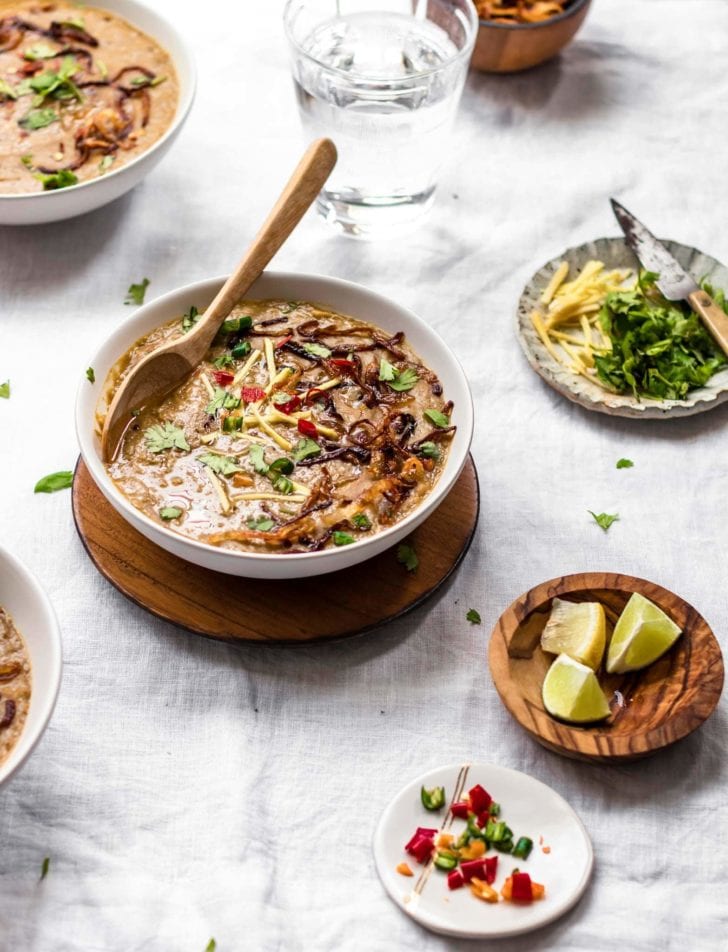
Want to save this post?
Enter your email below and get it sent straight to your inbox. Plus, get recipes & tips every week!
“I love this haleem recipe, haleem always felt very intimidating to me and this recipe broke it down very well. I’ve made it several times and it’s always delicious!”
Haniyyah
We all learn. A couple years ago, I said about my slow cooker haleem:
“Haleem, by nature, isn’t a 30-minute one-pot meal-with-ingredients-you-probably-have-on-hand. A good haleem takes time, a few pans, and most likely a trip to the nearest Indian/Pakistani/Middle-Eastern grocery store.”
Yet here I am. 2 years years later. Older, wiser, a mom of 2, a little less time and will in the kitchen.
And I’ve created a 30-minute one-pot haleem recipe. If you cook Pakistani food often, you probably have the ingredients on hand too.
What is Haleem?
Haleem (also called daleem, halim, etc.) is a Pakistani, Indian and/or Hyderabadi thick stew made with various grains, lentils (dal/daal), and meat.
Haleem is:
- nourishing
- rich in nutrients
- healthy
- comforting
- & chatpati (hot/sour/spicy/tangy)
Traditionally, each component is cooked separately, then mixed together and slow-cooked to achieve the thick and luscious texture. The resulting interwoven or ‘laced’ consistency is Haleem’s distinguishing feature.
Like Nihari, haleem is a celebratory, stand-alone dish that’s often served on special occasions.
What does Haleem taste like?
Haleem tastes like a rich porridge of legumes, meat, and grains. Onions, spices, and aromatics give it layers of complexity and nuance. The garnishing such as ginger, cilantro, and green chili peppers provides textural interest. Haleem a substantial meal in itself that feels healthy, nourishing, and incredibly satisfying.
Haleem Ingredients
While this recipe calls for several ingredients, all of them are readily available at most Indian and Pakistani grocery stores.
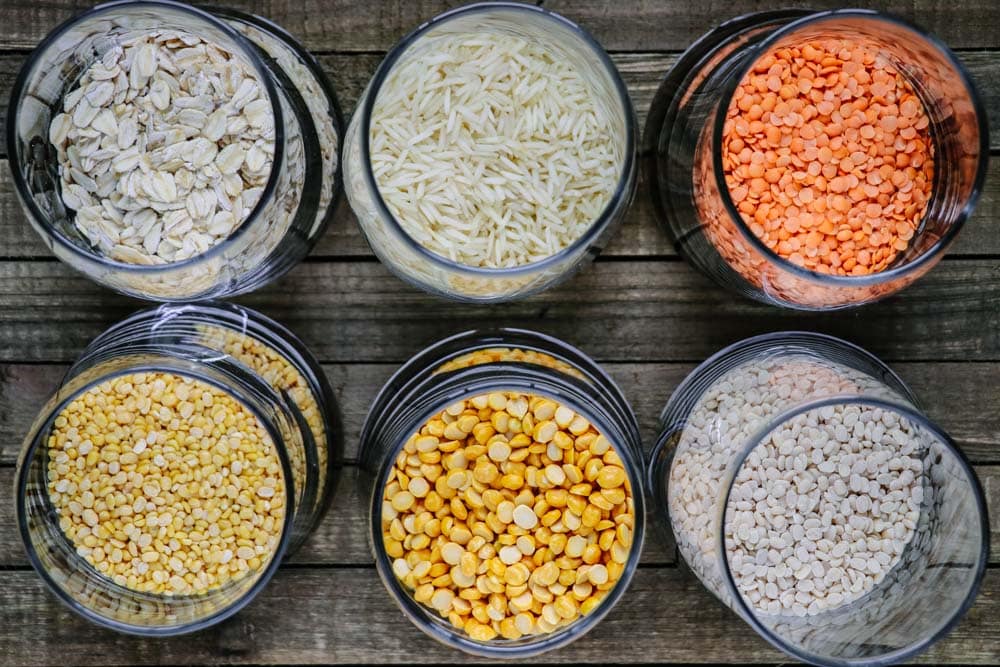
Besides the lentils and grains shown above, you’ll need meat (I use beef), onions, tomatoes, etc. and some traditional whole and ground spices.
Kitchen tools to make Haleem Easy:
- An Instant Pot
- A food processor
- An Immersion Blender – optional but recommended
- A mortar and pestle or spice grinder if you’re making your own haleem masala
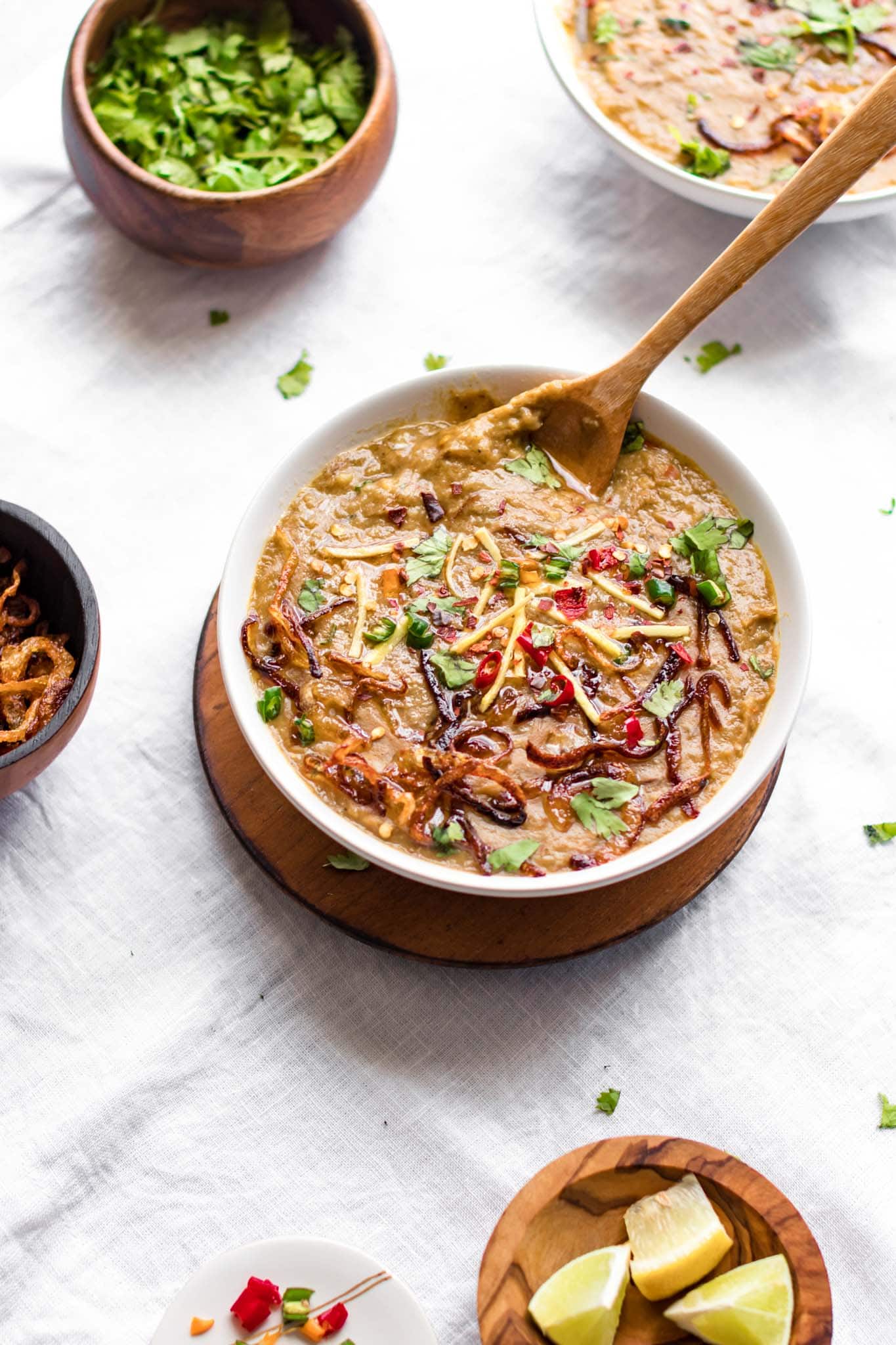
How to make Haleem in the Instant Pot
Here’s the plain and simple method broken down into 3 steps to give you an idea of how to make haleem in the Instant Pot. (If you’re new to the Instant Pot or just want to learn how to use it for Indian & Pakistani cooking, please check out my guide on How To Use The Instant Pot For Indian And Pakistani Cooking. For more Instant Pot recipes, I also have a collection of 15+ Easy Pakistani Instant Pot Recipes)
- Step 1: Soak grains and lentils. Sauté onions, garlic, and ginger. Add the meat, sauté for a bit, then add the rest of the IP ingredients and pressure cook with the Meat/Stew Setting.
- Step 2: Open the Pot. Remove the beef and give it just enough pulses in the food processor to shred. Then use an immersion blender to blend the lentils & grains. If you don’t have an immersion blender, run the lentils and grains through the food processor too.
- Step 3: Add oats and cook the haleem down. Once it starts bubbling, cover and slow cook until you can see the ‘laced’ consistency (or resha). If you’re up for it, make a tadka. Garnish and serve!
How to make Haleem on the Stovetop
If you’re making haleem on the stovetop, I’d suggest using my slow cooker haleem as a guide because the majority of it is done over the stovetop. I do plan on testing this on the stovetop and will update it when I do.
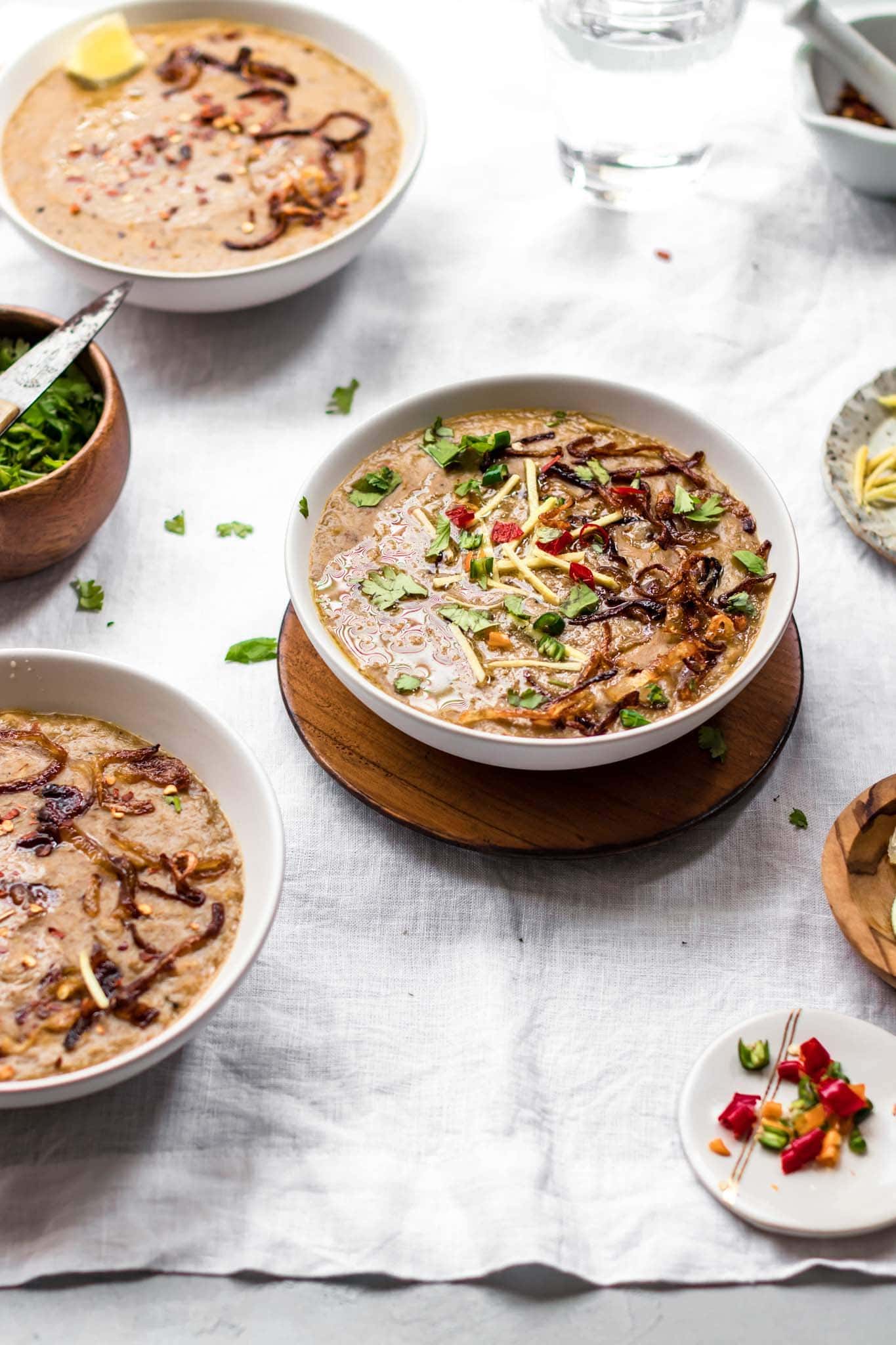
Haleem Masala Powder or Spice Mix
I understand not everyone has a range of exotic spices in their spice drawer, so I’ve developed this recipe to work with both store-bought and homemade haleem masala.
To make your own Haleem masala, combine the following ingredients in a spice grinder and process until smooth. You can also crush with a mortar and pestle. Makes ~1 tbsp.
- 1 tsp coriander seeds
- 1/2 tsp cumin seeds
- 1/2 small piece mace (javitri)
- 1/2 star anise (baadiyan)
- 1/4 tsp black peppercorns
- 1/8 tsp nigella seeds (kalonji)
- 1/8 tsp carom seeds (ajwain)
- Large pinch nutmeg powder
P.S. Don’t worry if you don’t have all of these spices. Just use whichever you have on hand.
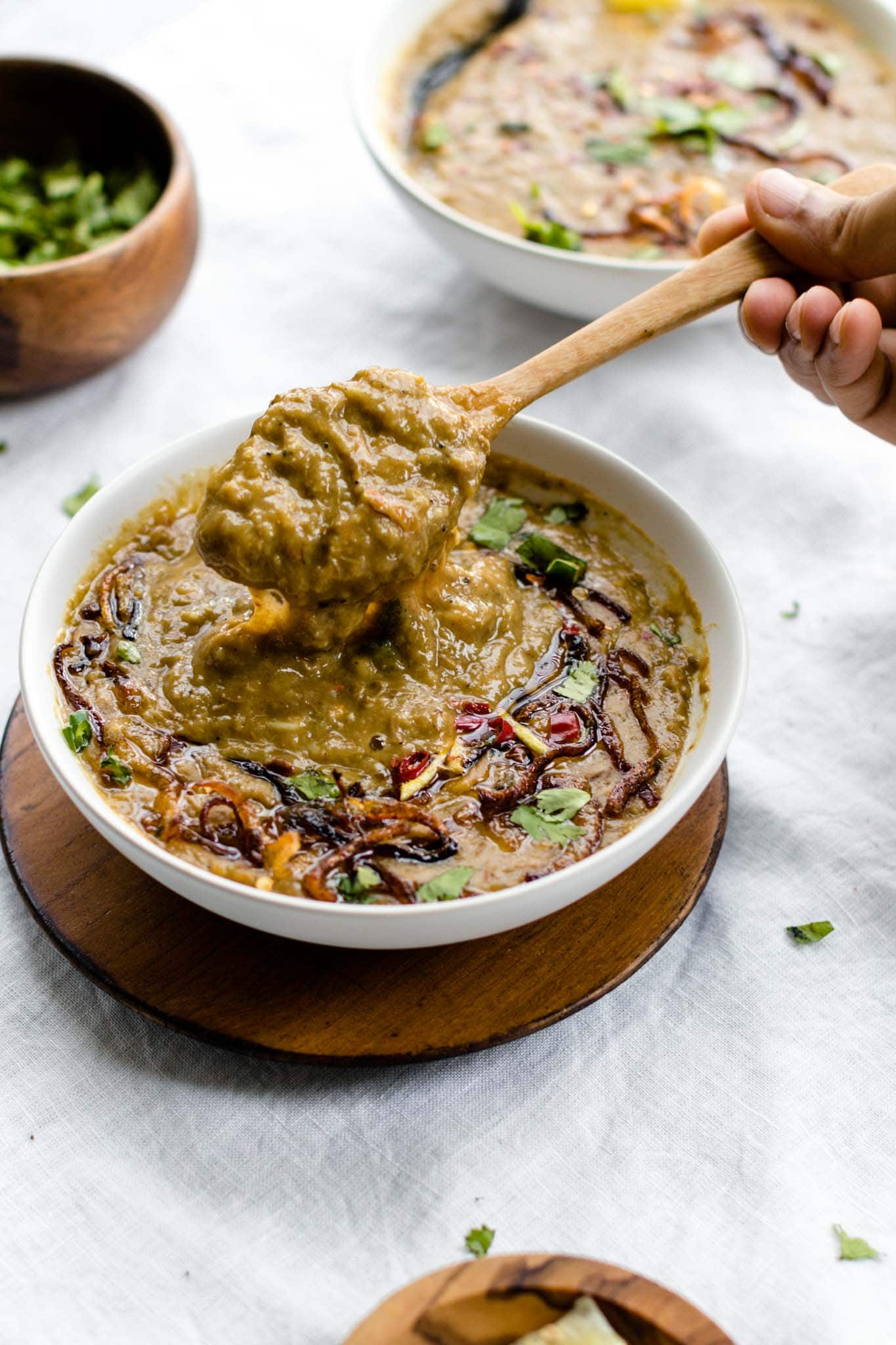
What cut of beef to use in Haleem
For haleem, you can use any pre-cut beef stew meat such as chuck, round, shank, or sirloin.
If you prefer to use bone-in beef or other meat, just remove the meat from the bones after cooking, and then proceed with the recipe.
How to make Haleem with Chicken or Mutton
Though I haven’t made haleem with chicken or mutton (goat/lamb) myself, they are popular haleem meat choices and can be used in this recipe in place of the beef. Lamb and goat meat should be fine to pressure cook for the same amount of time. If you’re using chicken, I’d suggest reducing the pressure cook time to 30 minutes.
How long does it take to make Haleem in the Instant Pot
The good thing about this haleem recipe is that it accounts for preparing the next set of ingredients while you’re doing the cooking. That said, it requires a good 2+ hours of total cook time. This includes pressure initial sauté, pressure build-up, pressure cooking, and final sauté.
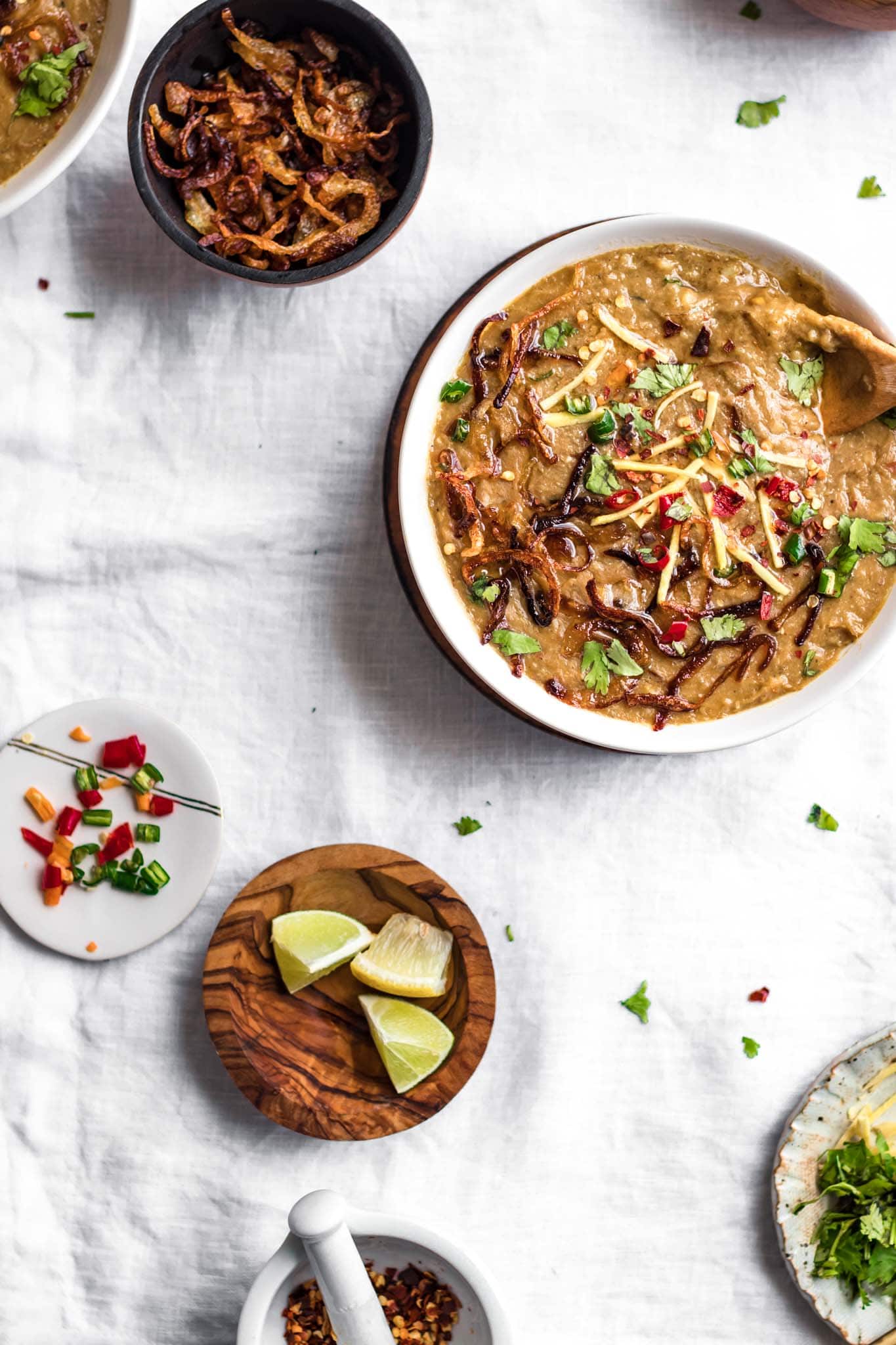
Final Tips to make Haleem
- When shredding the meat in the food processor, you want to maintain the shredded texture (or strands of the meat). To do that, use the pulse setting and process just until shredded.
- To double the recipe, double the ingredients (use the lower end of whole spices) and pressure cook for the same amount of time. Note that you’ll have to sauté longer at each step.
- The most important tip to make a good Haleem: It’s not finished once you combine the lentils and shredded meat. Cooking them down together is key to achieving the signature ‘laced’ consistency.
Haleem serving suggestions
Last year, I bought haleem at a food cart and was rummaging through the bag for naan when my friend laughed and said “Oh, you’re looking for naan? I think that’s a Punjabi thing”.
Though I grew up eating it with naan (and think it should be mandatory alongside haleem), I know it’s eaten alone with a spoon in many regions.
Haleem is best served with plenty of garnishing on the side.
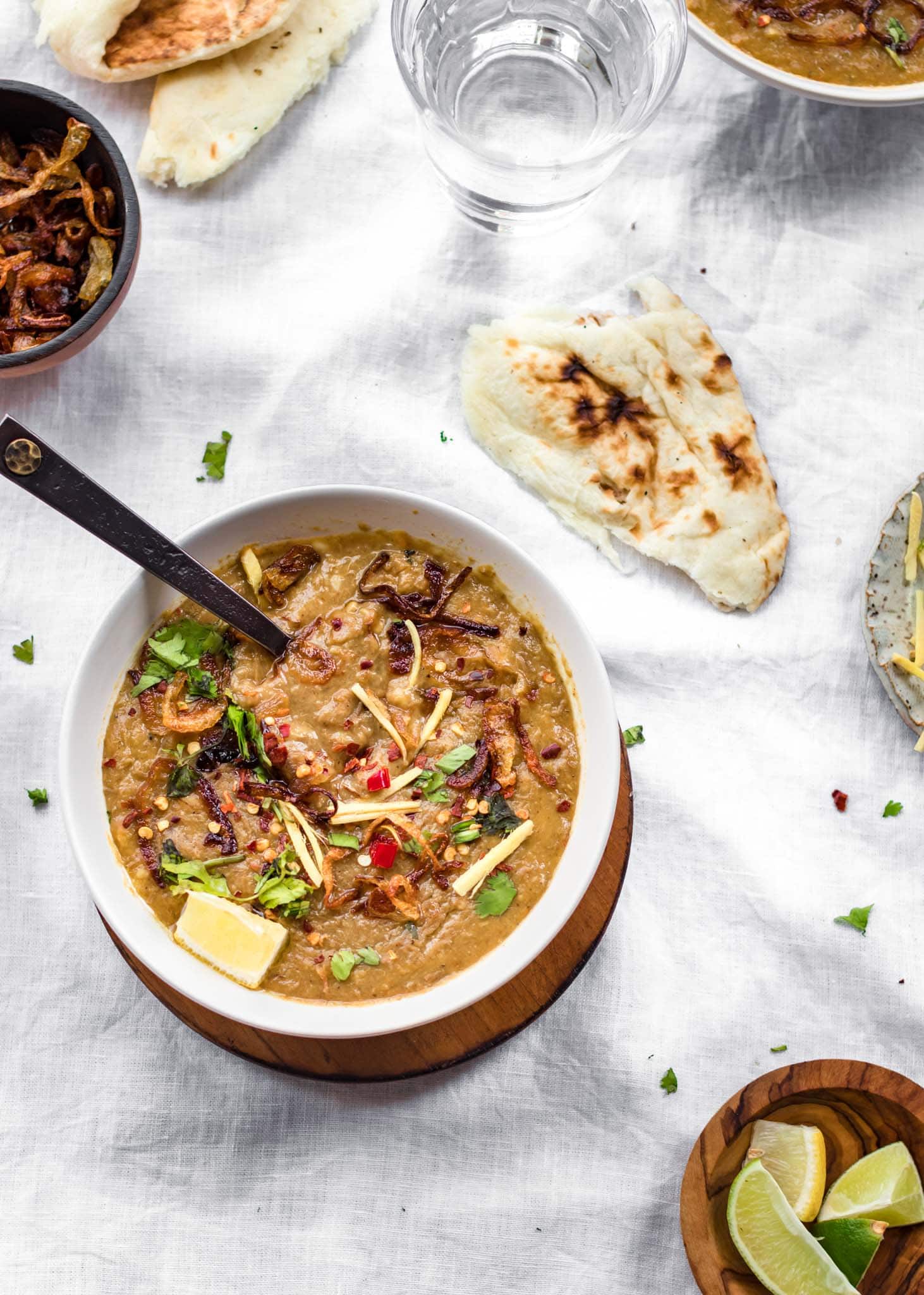
How to Freeze Haleem
Haleem freezes beautifully, and you can store it for up to 3 months. I suggest reheating it with a bit of water over the stovetop and adding a final tadka.
More Instant Pot Recipes
- Easy Instant Pot Pakistani Beef Curry (Stew)
- Instant Pot Butter Chicken (Easy & Authentic)
- Chana Pulao (Chickpea Pilaf) – 20 min prep!
- Instant Pot Red Lentil Daal
- Easy Shami Kebab (Instant Pot and Stovetop)
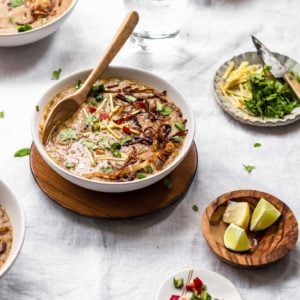
Easy Pakistani Haleem Recipe (Instant Pot)
Watch the Video
Ingredients
Lentils and Rice
- 1/4 cup (~48 g) chana dal, raw split chickpeas or sub yellow split peas
- 1/4 cup (~48 g) maash dal, split urad lentils
- 2 tbsp (~25 g) masoor dal, red split lentils
- 2 tbsp (~27 g) split moong dal, yellow lentils
- 2 tbsp (~24 g) basmati rice
Whole Spices
- 2-3 dried bay leaves
- 1-2 black cardamom pods
- 2-3 inch cinnamon stick
- 1 tsp cumin seeds
- 2-3 green cardamom pods, leave whole or remove seeds and grind into a powder using a mortar and pestle
- 4-5 whole cloves, leave whole or grind into a powder using a mortar and pestle
For the Instant Pot
- 2 (~300 g) small onions or 1 large, cut into eights
- 6 garlic cloves, peeled
- 1 inch piece ginger, peeled and roughly chopped
- 1/4 cup neutral oil such as grapeseed or canola
- 2 tbsp ghee
- 1 lb beef stew meat, cut into 1 – 1 ½ inch cubes
- 2 (~250 g) medium tomatoes, quartered
- 1-2 green chili peppers, stems removed and sliced
- 1 tbsp haleem masala powder, homemade (see post for recipe) or store-bought
- 1-2 tsp red chili flakes
- 3/4 tsp turmeric powder
- 2 1/2 – 2 3/4 tsp table salt or sea salt, start with 2 1/4 tsp if using store-bought haleem masala
- 2 tbsp whole milk yogurt
- 3 cups water
After Cooking
- 1/4 cup rolled oats, or sub instant oats
- 1/2 tsp garam masala or chaat masala
- 1/4 tsp freshly ground black pepper
For the Tadka (Tempering) – Optional
- 1 (~85 g) small or half medium onion, thinly sliced
- 2-3 tbsp ghee or oil
Garnishing
- 1/4 cup cilantro leaves, finely chopped
- 1 inch ginger, julienned
- 1-2 green chili peppers, finely chopped
- 1 lemon or lime, cut into wedges
- chaat masala or garam masala – optional
- mint leaves – optional
Instructions
- In a medium bowl, combine the lentils and rice and rinse a few times until the water runs clear. Fill the bowl with warm water and allow to soak. Set aside.
- Place the onion, garlic, and ginger in a food processor and pulse to chop finely (but not blend).
- Turn Instant Pot on Sauté mode and set to More/High. Once hot, add oil, ghee, and chopped onion mixture. Sauté for about 8-10 minutes, until the onions are lightly golden. While the onions are sautéing, add all the spices listed under Whole Spices.
- Add the meat and sauté until the color of the meat changes (~5 minutes). Meanwhile, pulse to chop the tomatoes and green chilies in the food processor. Set aside.
- Add the spices (haleem masala, red chili flakes, and turmeric) and salt and sauté for 30 seconds. Add the chopped tomato mixture and yogurt along with 3 cups of water.
- Drain the soaked lentils and rice and add it to the Instant Pot. Mix to combine. Cancel Sauté. Cover the Instant Pot and set the valve to Sealing. Select the Meat/Stew Setting to set the pressure time to 45 minutes.
- Allow the pressure to naturally release for at least 5 minutes, and then manually release the remaining pressure. Open the pot, and use a slotted spoon and tong to remove the beef pieces and add them to the food processor. Discard any large whole spices (the bay leaves, cinnamon stick, etc.) as they come up. Pulse to process the beef until it is just shredded and stringy but not smooth (7-8 pulses). (Alternatively, shred the beef in a stand mixer on low speed.)
- Use an immersion blender to blend the dal until smooth. (You can also blend in the food processor after shredding the beef.) Turn the Instant Pot on to Sauté mode and set to Less.
- Add the shredded beef and rolled oats and stir. Sauté for 3-5 minutes to cook this mixture down. Once the haleem starts bubbling, cancel sauté and cover with a lid.
- Select Slow Cook and set to More/High. Allow to cook, stirring occasionally, for an additional 20-30 minutes (See Note 1). The haleem is done once a 'laced' consistency is achieved. (See Note 2) If the haleem thickens too much, add 1/2-1 cup boiling water and continue to stir. Add the garam masala and black pepper and stir to mix.
Tadka (Optional Step)
- In a medium skillet, heat ghee or oil over medium-high heat. Add the onions and sauté, stirring occasionally, until golden brown (~5-6 min). Stir more cautiously toward the end because you want them the deep brown color but not burnt.
- Pour the tadka over the haleem. Garnish and serve with more garnishing on the side.


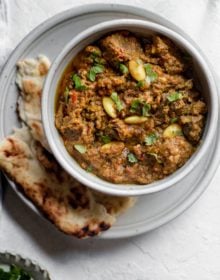
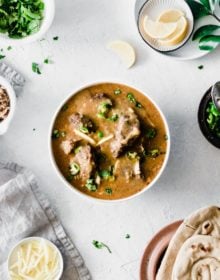
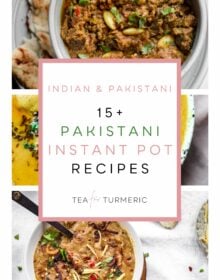

97 Comments on “Easy Pakistani Haleem Recipe (Instant Pot)”
Hi , I wanting to try this recipe with boneless chicken breast would the cooking instruction’s or time be the same
Thanks!
Hi, do you have the haleem recipe for the stove top? it would be great if you do.
Hi Fiona, We have an Instant Post and Slow Cooker Haleem but currently don’t have a Haleem recipe tested for the stovetop. You can find some tips here on how to make on the stovetop.
Love this recipe!! I’ve made it twice and it’s turned out great both times. I just wanted to know how long u recommend soaking the lentils for? Is it better overnight?
Thank you Hadiya! You don’t need to soak overnight, because they cook for with the beef. 30-60 minutes should be enough time.
This recipe is AMAZING. I was rather nervous about making it — I didn’t even slice the onion for the tarka until I had opened the IP lid for fear I’d jinx it — but it turned out so so great! I didn’t have maash or moong, so I used 1/4 cup of bulgur instead and added a tsp more of the masoor daal. I made it with chicken and followed the note for 30 minutes of cook time. I was able to use an immersion blender to whizz everything (I had very small pieces of chicken to start off with) so I didn’t add the chicken to a food processor separately. It turned out the right consistency, and I am so delighted with it! Thank you for this!
Yay! So glad to hear you enjoyed the Haleem! Thank you for sharing your changes as well 🙂
Tomatoes in haleem?? Good lord! I haven’t heard of anything more ridiculous!! 😑🤦♀️
Hi Tanya, I have to disagree about tomatoes being ridiculous in Haleem. There are many ways of cooking Haleem across South Asia. A little googling will show that there are a number of recipes which use tomatoes. If you give the recipe a try, you may just like the addition of tomatoes!
If using pearl barley, do they need to be soaked with the lentils and rice or added dry at the same time?
Hi Amina, No need to soak the pearl barley. Just add it with the lentils and rice. Please share how it turns out!
This was my first attempt at making haleem and my first time using my insta pot and I was truly astonished at how well it turned out!
Like many other commenters, I used pearl barley instead of oats and put it in with the lentils. Also added some bones for flavour. So yummm. Thank you, Izzah! Definitely going to try more recipes
Hi Zehra, We are so glad you enjoyed it and love the addition of bones…it always add more flavour!